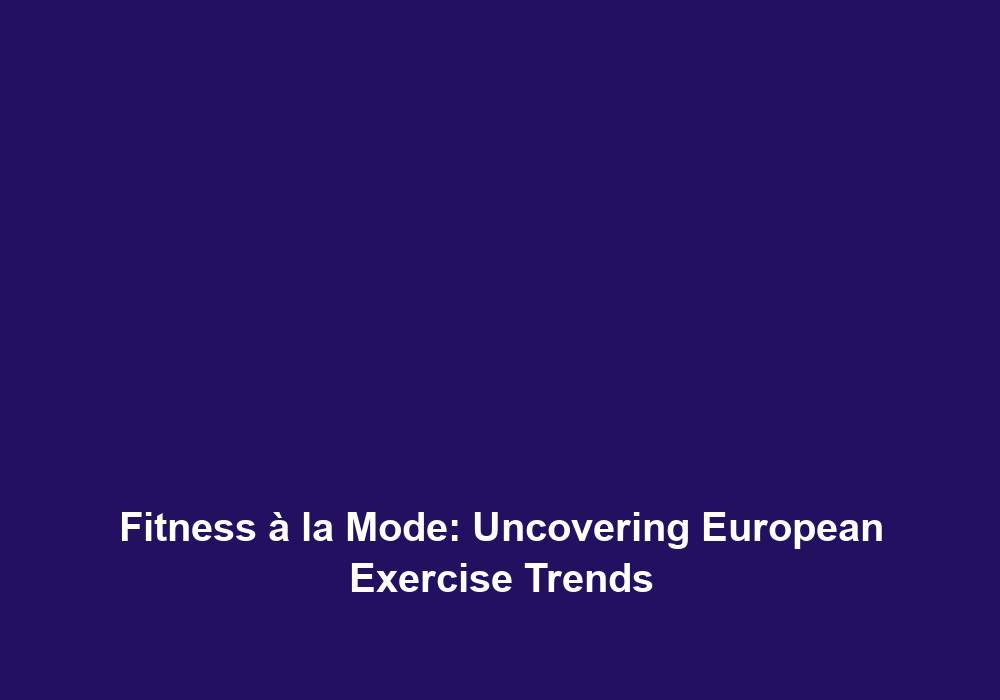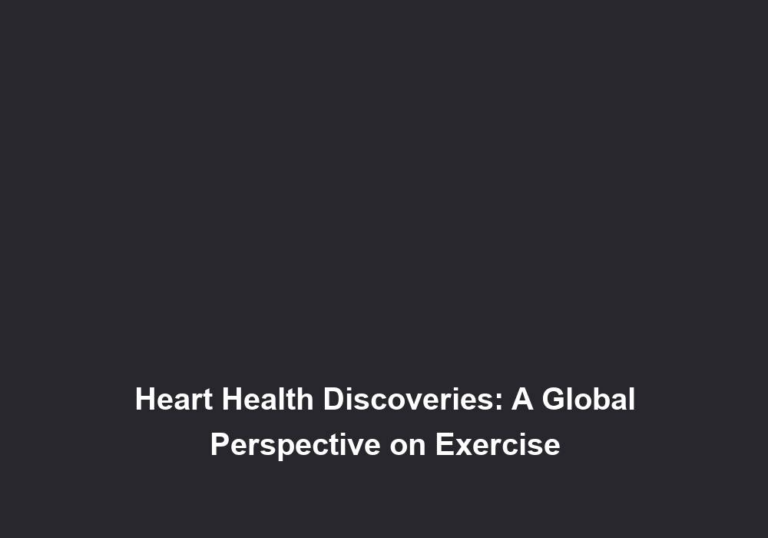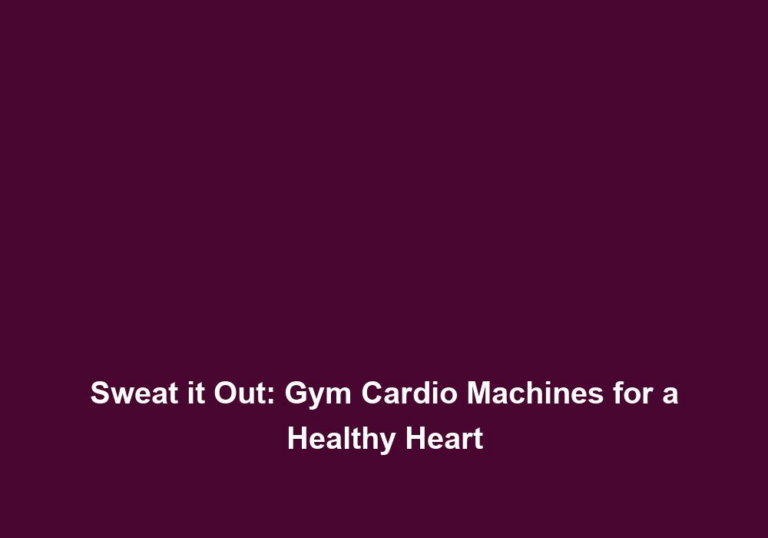Fitness à la Mode: Uncovering European Exercise Trends
With the increasing emphasis on health and wellness, people around the world are constantly seeking new and exciting ways to stay fit. When it comes to exercise trends, Europe has always been at the forefront, adopting innovative and effective fitness practices that are often later embraced by the rest of the world. In this article, we will delve into the fascinating world of European exercise trends, exploring the unique approaches and techniques that have gained popularity across the continent.
1. HIIT: High-Intensity Interval Training
High-Intensity Interval Training (HIIT) has taken the fitness world by storm in recent years, and Europe is no exception to this trend. HIIT workouts involve short bursts of intense exercise followed by brief recovery periods. This highly efficient training method not only helps to burn calories but also improves cardiovascular fitness and boosts metabolism. Europeans have recognized the benefits of HIIT and have incorporated it into their workout routines to maximize their results in minimal time.
The beauty of HIIT lies in its versatility. It can be tailored to individual fitness levels and preferences, making it accessible to people of all ages and abilities. Whether it’s a rigorous session of sprints, a circuit of bodyweight exercises, or a combination of both, HIIT provides a challenging and effective workout that keeps the body guessing and the metabolism revving. Plus, the short duration of the high-intensity intervals means that even the busiest individuals can find time to squeeze in a HIIT session.
To further enhance the effectiveness of HIIT, Europeans have started incorporating various equipment and techniques. Some popular additions include kettlebells, resistance bands, and battle ropes. These tools add resistance and intensity to the exercises, helping to build strength and improve overall fitness. Additionally, HIIT can be combined with other forms of exercise, such as plyometrics or yoga, to create a well-rounded and dynamic workout routine.
In summary, HIIT has become a staple in European fitness culture due to its time efficiency and effectiveness. By incorporating short bursts of intense exercise into their routines, Europeans are able to achieve their fitness goals while maximizing their time and effort.
2. Outdoor Fitness
Europeans have a deep appreciation for nature and the great outdoors. It is no surprise, therefore, that outdoor fitness has become a significant trend across the continent. From hiking and trail running to outdoor yoga and boot camps, people are embracing the benefits of exercising in natural surroundings.
One of the main advantages of outdoor fitness is the exposure to fresh air and natural light. This not only enhances the overall workout experience but also provides numerous health benefits. Breathing in fresh air can improve lung function, while exposure to natural light boosts vitamin D levels and promotes a sense of well-being. In addition, outdoor environments often present varying terrains and challenges, which can engage different muscle groups and improve balance and coordination.
Europe offers a diverse range of landscapes, from majestic mountains to picturesque coastlines, providing the perfect backdrop for outdoor fitness activities. Whether it’s hiking in the Swiss Alps, running along the beaches of the Mediterranean, or practicing yoga in a tranquil park, Europeans are taking advantage of the natural beauty that surrounds them.
Moreover, outdoor fitness allows for a sense of freedom and exploration. Instead of being confined to the four walls of a gym, individuals can venture out and discover new trails, parks, and scenic spots. This not only adds excitement and novelty to the workout routine but also provides an opportunity to connect with nature and appreciate the world around us.
In summary, outdoor fitness has gained popularity in Europe due to its numerous benefits for both physical and mental well-being. By exercising in natural surroundings, Europeans are able to enjoy the fresh air, natural light, and diverse landscapes while staying fit and active.
3. Functional Training
Functional training focuses on enhancing the body’s ability to perform everyday activities efficiently and safely. European fitness enthusiasts have embraced this trend wholeheartedly, recognizing the importance of functional movements in improving overall quality of life.
Functional training exercises mimic real-life movements and often incorporate the use of equipment such as kettlebells, resistance bands, and stability balls. By training the body to move in a coordinated and balanced way, functional training helps improve strength, flexibility, and overall body control. Europeans have realized that by incorporating these functional movements into their workout routines, they can better prepare their bodies for the demands of daily life, reduce the risk of injuries, and improve their overall physical performance.
In addition to the physical benefits, functional training also offers mental and cognitive advantages. The focus on coordination, balance, and proprioception (awareness of body position in space) helps to enhance mind-body connection and improve cognitive function. This aspect of functional training is particularly appealing to Europeans who prioritize holistic well-being and strive for a balanced and integrated approach to fitness.
To further enhance the effectiveness of functional training, Europeans have begun incorporating specific training protocols and techniques. These may include exercises that target core stability, balance training, and multi-joint movements. By targeting these key areas, functional training helps individuals develop a strong foundation for movement, improve posture, and prevent imbalances or weaknesses that can lead to injuries.
In summary, functional training has gained popularity in Europe due to its emphasis on real-life movements and overall functional fitness. By incorporating these exercises into their routines, Europeans are able to improve their physical performance, reduce the risk of injuries, and enhance their overall well-being.
4. Group Fitness Classes
Group fitness classes have been a long-standing trend in Europe, and their popularity continues to grow. Whether it’s Zumba, spinning, or body combat, Europeans love the energy and camaraderie that comes with working out in a group setting.
One of the major advantages of group fitness classes is the motivation and accountability they provide. Exercising alongside like-minded individuals creates a sense of community and support, making it easier to stay motivated and committed to a regular workout routine. Additionally, the energy and enthusiasm of the group can be contagious, pushing individuals to challenge themselves and reach new fitness levels.
Group fitness classes also offer a wide variety of workout styles and formats, ensuring there is something for everyone. From high-intensity cardio classes to mind-body practices like yoga and Pilates, Europeans have access to a diverse range of options to suit their preferences and goals. This variety not only keeps workouts interesting and engaging but also allows individuals to target different aspects of fitness, such as strength, flexibility, and cardiovascular endurance.
Furthermore, group fitness classes provide professional guidance and expertise. Instructors are trained to design safe and effective workouts, ensuring participants get the most out of their sessions. They can provide modifications and progressions to accommodate different fitness levels and abilities, making group classes inclusive and accessible to all.
In summary, group fitness classes have gained popularity in Europe due to the motivation, variety, and professional guidance they provide. By joining a group class, Europeans can add fun and social interaction to their workout routine, increase their accountability, and work towards their fitness goals in a supportive environment.
5. Mindful Movement: Yoga and Pilates
Europeans have embraced the mind-body connection by adopting practices such as yoga and Pilates. These mindful movement disciplines not only improve physical strength and flexibility but also promote mental well-being and stress reduction.
Yoga, with its various styles such as Vinyasa, Ashtanga, and Hatha, has become incredibly popular across Europe. It offers a holistic approach to fitness, emphasizing the importance of breathing, mindfulness, and body awareness. Through a series of postures, breathing exercises, and meditation, yoga helps individuals cultivate a sense of inner peace, improve focus and concentration, and reduce stress and anxiety.
Pilates, on the other hand, focuses on core strength, stability, and control. It emphasizes precise movements and proper alignment, helping to strengthen the deep muscles of the abdomen and back. By incorporating mindful breathing and controlled movements, Pilates promotes body awareness, improves posture, and enhances overall body strength and flexibility.
Both yoga and Pilates offer a range of benefits for physical and mental well-being. From increased flexibility and muscle tone to stress reduction and improved sleep quality, Europeans have recognized the value of these mindful movement practices in achieving a balanced and healthy lifestyle.
To further enhance the experience of yoga and Pilates, Europeans have embraced variations and modifications. For example, aerial yoga, which involves performing yoga postures while suspended from a hammock, has gained popularity for its unique challenge and the added element of fun. Similarly, Pilates reformer classes, which utilize specialized equipment, provide a different dimension to the practice, allowing for increased resistance and variability in movements.
In summary, yoga and Pilates have become integral parts of European fitness culture due to their holistic approach to well-being. By incorporating these mindful movement practices into their routines, Europeans are able to improve physical strength and flexibility, reduce stress, and cultivate a sense of inner peace.
6. Technology in Fitness
Europeans have incorporated technology into their fitness routines, leveraging its benefits to enhance their workouts. Fitness trackers, smartwatches, and mobile applications have become essential tools for tracking progress, setting goals, and monitoring various health metrics.
Fitness trackers, such as Fitbit and Garmin, provide real-time data on steps taken, calories burned, and heart rate. They also offer features like sleep tracking and sedentary reminders to promote overall health and well-being. By monitoring these metrics, Europeans can gain insight into their daily activity levels and make informed decisions about their fitness routines and lifestyle habits.
Smartwatches, on the other hand, offer additional functionalities beyond fitness tracking. They allow users to receive notifications, answer calls, and even stream music, making them a convenient all-in-one device for staying connected while working out. Europeans appreciate the versatility and convenience of smartwatches, as they can seamlessly transition from their fitness activities to their daily tasks without missing a beat.
Mobile applications have also revolutionized the fitness industry by providing access to a wide range of workout programs, nutrition guidance, and virtual personal training sessions. Europeans can now find customized workout routines, track their nutrition, and even participate in virtual fitness classes from the comfort of their own homes. This integration of technology in fitness has made it easier for Europeans to stay motivated, accountable, and connected to the fitness community, regardless of their location or schedule.
In summary, technology has become an integral part of European fitness routines, offering valuable insights, convenience, and connectivity. By leveraging fitness trackers, smartwatches, and mobile applications, Europeans can enhance their workouts, set and achieve goals, and stay connected to the ever-evolving fitness landscape.
7. Wellness Retreats
Wellness retreats have gained immense popularity in Europe, offering individuals the opportunity to escape their everyday lives and focus on their well-being. These retreats often include a combination of fitness activities, mindfulness practices, healthy meals, and relaxation.
Europe offers a diverse range of wellness retreats, catering to various interests and preferences. Whether it’s a yoga retreat in the Greek islands, a hiking getaway in the Swiss Alps, or a spa retreat in the countryside, Europeans are eager to invest in their physical and mental health through these immersive experiences.
Wellness retreats provide a much-needed break from the daily grind, allowing individuals to disconnect from technology and reconnect with themselves and nature. They offer a sanctuary for relaxation and self-reflection, providing a space to recharge and rejuvenate. Participants can engage in activities such as yoga, meditation, hiking, and spa treatments, all designed to promote physical, mental, and emotional well-being.
In addition to the physical and mental benefits, wellness retreats also emphasize healthy eating and nutrition. Participants are often served nutritious meals made from locally sourced ingredients, providing them with the fuel they need to nourish their bodies and support their fitness goals. This focus on holistic wellness encourages Europeans to adopt healthy habits and make sustainable lifestyle changes even after the retreat ends.
In conclusion, European exercise trends showcase a diverse range of approaches to fitness and well-being. From high-intensity interval training and outdoor fitness to functional training and group fitness classes, Europeans are constantly exploring new ways to stay active and lead a healthier lifestyle. Additionally, the integration of technology and the rise of wellness retreats demonstrate the continent’s commitment to holistic wellness. So, whether you’re in Europe or anywhere else in the world, why not take inspiration from these trends and incorporate them into your own fitness routine? Remember, staying fit is not just a trend but a lifelong journey towards a healthier and happier you.







